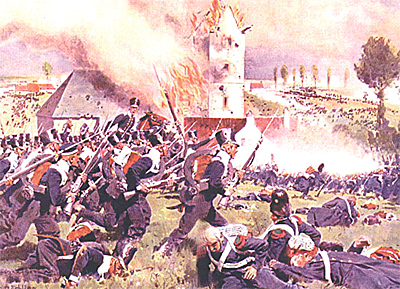A Belle Alliance
The Battle About Books
About the Battle
Initial Sighting of Prussians
by Gary Cousins, Germany
| |
The first concerns the initial sighting of the Prussians and its effect on the French conduct of the battle. Mr. Hofschröer (following many others) says that, around 1pm, Napoleon noticed a movement about 9km to his right, which was deduced to be the Prussians advancing towards the battlefield, and immediately moved Lobau's VI Corps plus the cavalry of Domon and Subervie to face the threat: " …Therefore, before the main part of the battle had begun, the Prussian manoeuvre had already tied down over 9,000 French troops" ("Victory", p.79). The "success" of this "manoeuvre" supposedly reduced the number of French troops available to directly face Wellington’s army, and gave Wellington local numerical superiority from the start, thus devaluing any result he might achieve and by implication enhancing the contribution of the Prussians. However, "History" says that this sighting deflected French troops towards the Prussians and away from Wellington’s line far later: "It is even doubtful if the whole of this cavalry [Domon and Subervie] moved off so early as above stated [i.e. shortly after 1pm]." In the "Memoires historiques de Napoleon, Livre ix," it is asserted that Domon was despatched with these two divisions when the distant column was first seen; but according to the observations made by the Prussian advanced parties in front of the wood of Paris, it would appear that the cavalry in question marched off at a later period. It is further asserted by the same authority that shortly afterwards, Lobau was ordered to march with his corps to the support of the light cavalry in the vicinity of St. Lambert. This is decidedly incorrect. The advance of Lobau's Corps to the right was distinctly observed from the extreme left of the Duke of Wellington's army, and from the Prussian side of the field, at a much later period of the day" ("History", p.245, footnote). Later in "History", the diversion of the cavalry of Domon and Subervie is timed as taking place at "about one o’clock"; that of Lobau’s VI corps and the Young Guard to oppose the Prussians at "about six o’clock" ("History", pp.388, 389). "History" says that the Prussian arrival and advance surprised the French. The Blücher / Gneisenau Report [7] agrees about the urgency of the response, and if not with "History"’s timing, at least that it was after the Prussians arrived: for as they began their assault, (after 4.30pm, but before 6pm), "…the enemy did not lose his presence of mind; he instantly turned his reserve against us…". The book published by the Prussian officer Carl von Plotho [8] in Berlin in 1818, which Mr. Hofschröer has called the first authoritative German language history of the 1815 campaign, which says that the initial attack of the Prussians was opposed by only a line of French skirmishers and cavalry ("Verbund", p.66), and his chronology implies that it was after 4.30pm that Napoleon swung Lobau’s VI Corps and the Young Guard, until then in reserve behind
the main French position, to face the Prussians ("Verbund", p.67). Vivian also recalls seeing the French reserve and right form to face the Prussians at Plancenoit between 5pm and 6pm: "…I should say nearer five…" ("Letters", p.161). There is
a need for some research into this discrepancy to establish the operational facts, and the "true" quantitative and qualitative impact.
A Belle Alliance The Battle About Books About the Battle
|

